ignition Seat Ateca 2018 Owner's Guide
[x] Cancel search | Manufacturer: SEAT, Model Year: 2018, Model line: Ateca, Model: Seat Ateca 2018Pages: 348, PDF Size: 7.32 MB
Page 87 of 348
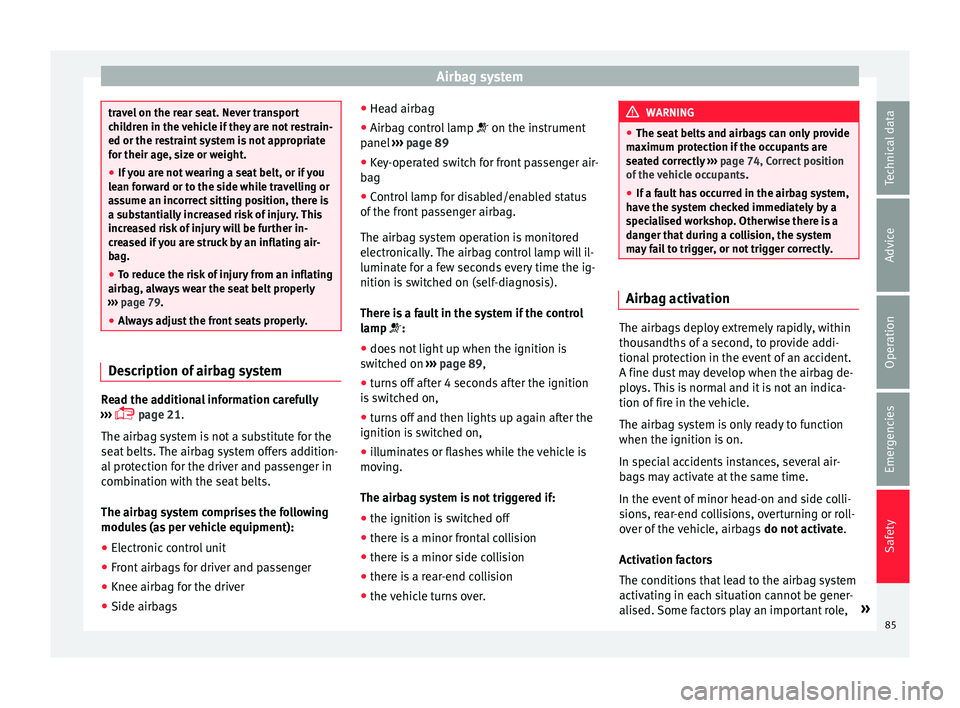
Airbag system
travel on the rear seat. Never transport
chi
l
dren in the vehicle if they are not restrain-
ed or the restraint system is not appropriate
for their age, size or weight.
â If you are not wearing a seat belt, or if you
lean f
orward or to the side while travelling or
assume an incorrect sitting position, there is
a substantially increased risk of injury. This
increased risk of injury will be further in-
creased if you are struck by an inflating air-
bag.
â To reduce the risk of injury from an inflating
airbag, alw
ays wear the seat belt properly
âºâºâº page 79.
â Always adjust the front seats properly. Description of airbag system
Read the additional information carefully
⺠âº
âº
ï¨ page 21.
The airbag system is not a substitute for the
seat belts. The airbag system offers addition-
al protection for the driver and passenger in
combination with the seat belts.
The airbag system comprises the following
modules (as per vehicle equipment): â Electronic control unit
â Front airbags for driver and passenger
â Knee airbag for the driver
â Side airbags â
Head airb
ag
â Airbag control lamp ï´ on the instrument
p
anel âºâºâº page 89
â Key-operated switch for front passenger air-
bag
â Contr
ol lamp for disabled/enabled status
of the front
passenger airbag.
The airbag system operation is monitored
electronically. The airbag control lamp will il-
luminate for a few seconds every time the ig-
nition is switched on (self-diagnosis).
There is a fault in the system if the control
lamp ï´:
â does not light up when the ignition is
switc
hed on âºâºâº page 89,
â turns off after 4 seconds after the ignition
is sw
itched on,
â turns off and then lights up again after the
ignition is sw
itched on,
â illuminates or flashes while the vehicle is
movin
g.
The airbag system is not triggered if:
â the ignition is switched off
â there is a minor frontal collision
â there is a minor side collision
â there is a rear-end collision
â the vehicle turns over. WARNING
â The seat belt
s and airbags can only provide
maximum protection if the occupants are
seated correctly âºâºâº page 74, Correct position
of the vehicle occupants .
â If a fault has occurred in the airbag system,
have the sy
stem checked immediately by a
specialised workshop. Otherwise there is a
danger that during a collision, the system
may fail to trigger, or not trigger correctly. Airbag activation
The airbags deploy extremely rapidly, within
thou
s
andths
of a second, to provide addi-
tional protection in the event of an accident.
A fine dust may develop when the airbag de-
ploys. This is normal and it is not an indica-
tion of fire in the vehicle.
The airbag system is only ready to function
when the ignition is on.
In special accidents instances, several air-
bags may activate at the same time.
In the event of minor head-on and side colli-
sions, rear-end collisions, overturning or roll-
over of the vehicle, airbags do not activate.
Activation factors
The conditions that lead to the airbag system
activating in each situation cannot be gener-
alised. Some factors play an important role, »
85
Technical data
Advice
Operation
Emergencies
Safety
Page 90 of 348
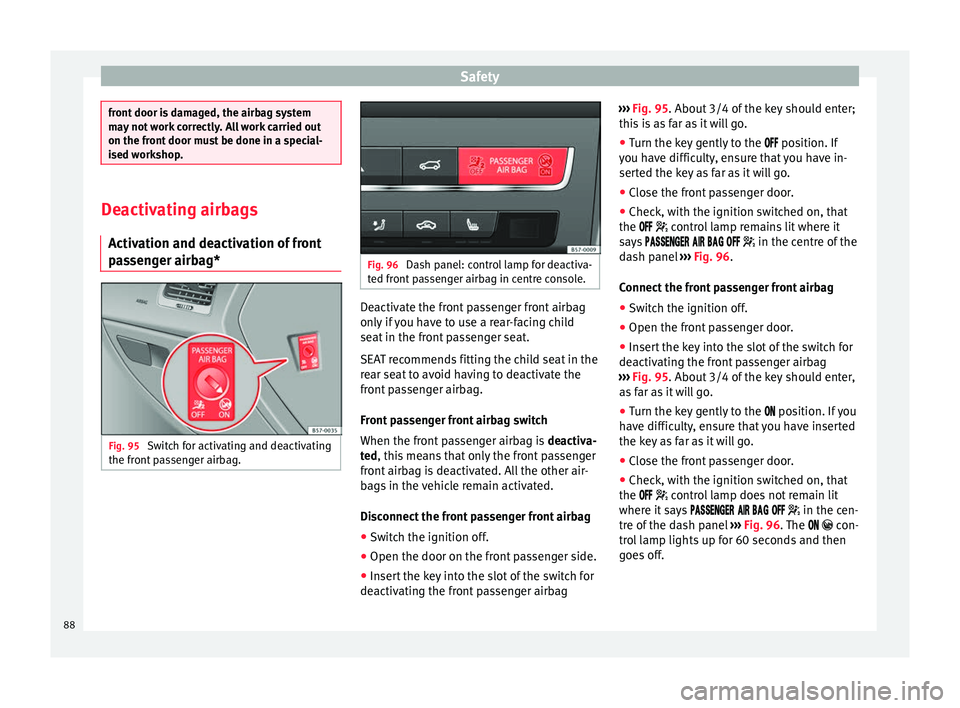
Safety
front door is damaged, the airbag system
ma
y
not work correctly. All work carried out
on the front door must be done in a special-
ised workshop. Deactivating airbags
Activ ation and de
activation of front
passenger airbag* Fig. 95
Switch for activating and deactivating
the fr ont
p
assenger airbag. Fig. 96
Dash panel: control lamp for deactiva-
ted fr ont
passenger airbag in centre console. Deactivate the front passenger front airbag
on
ly
if
you have to use a rear-facing child
seat in the front passenger seat.
SEAT recommends fitting the child seat in the
rear seat to avoid having to deactivate the
front passenger airbag.
Front passenger front airbag switch
When the front passenger airbag is deactiva-
ted, this means that only the front passenger
front airbag is deactivated. All the other air-
bags in the vehicle remain activated.
Disconnect the front passenger front airbag
â Switch the ignition off.
â Open the door on the front passenger side.
â Insert the key into the slot of the switch for
deactivatin
g the front passenger airbag âºâºâº
Fig. 95. About 3/4 of the k
ey should enter;
this is as far as it will go.
â Turn the key gently to the ïïï position. If
y
ou have difficulty, ensure that you have in-
serted the key as far as it will go.
â Close the front passenger door.
â Check, with the ignition switched on, that
the ïïï ï¹ contro
l lamp remains lit where it
says ïïïïï
ïïï
ï ïïï ïïï ïïï ï¹ in the centre of the
dash panel âºâºâº Fig. 96.
Connect the front passenger front airbag â Switch the ignition off.
â Open the front passenger door.
â Insert the key into the slot of the switch for
deactivatin
g the front passenger airbag
âºâºâº Fig. 95. About 3/4 of the key should enter,
as far as it will go.
â Turn the key gently to the ïï position. If
you
have difficulty, ensure that you have inserted
the key as far as it will go.
â Close the front passenger door.
â Check, with the ignition switched on, that
the ïïï ï¹ contro
l lamp does not remain lit
where it says ïïïïï
ïïï
ï ïïï ïïï ïïï ï¹ in the cen-
tre of the dash panel âºâºâº Fig. 96. The ïï ï¶ con-
trol lamp lights up for 60 seconds and then
goes off.
88
Page 91 of 348
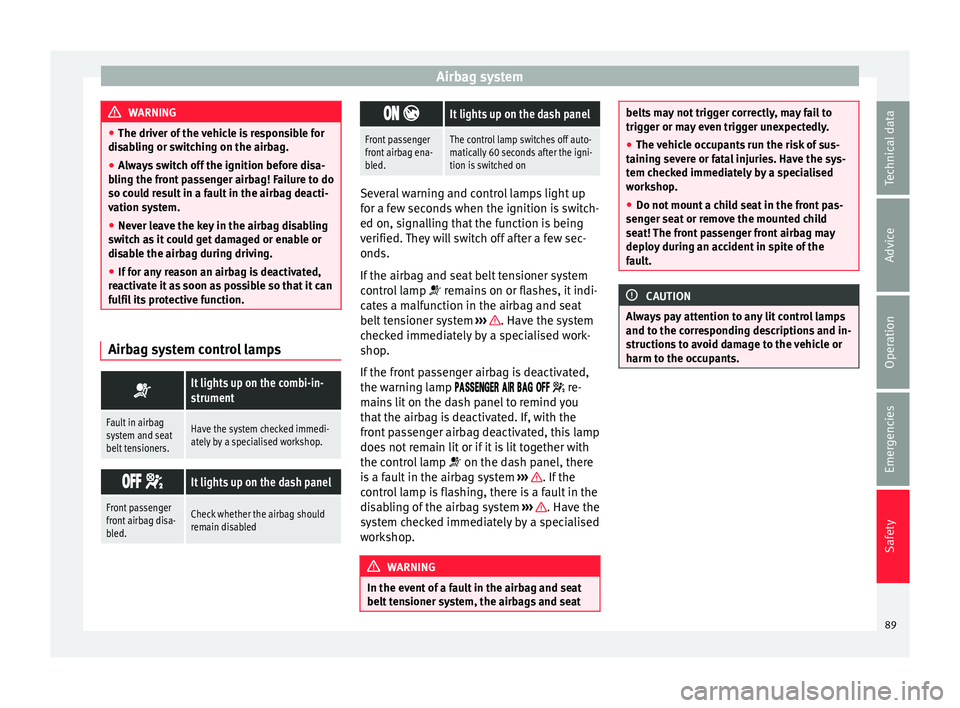
Airbag system
WARNING
â The driver of the
vehicle is responsible for
disabling or switching on the airbag.
â Always switch off the ignition before disa-
bling the fr
ont passenger airbag! Failure to do
so could result in a fault in the airbag deacti-
vation system.
â Never leave the key in the airbag disabling
switc
h as it could get damaged or enable or
disable the airbag during driving.
â If for any reason an airbag is deactivated,
reactiv
ate it as soon as possible so that it can
fulfil its protective function. Airbag system control lamps
ï´
It lights up on the combi-in-
strument
Fault in airbag
system and seat
belt tensioners.Have the system checked immedi-
ately by a specialised workshop.
ïïï
ï¹
It lights up on the dash panel
Front passenger
front airbag disa-
bled.Check whether the airbag should
remain disabled ïï ï¶
It lights up on the dash panel
Front passenger
front airbag ena-
bled.The control lamp switches off auto-
matically 60 seconds after the igni-
tion is switched on
Several warning and control lamps light up
for a f
ew sec
onds when the ignition is switch-
ed on, signalling that the function is being
verified. They will switch off after a few sec-
onds.
If the airbag and seat belt tensioner system
control lamp ï´ remains on or flashes, it indi-
cates a malfunction in the airbag and seat
belt tensioner system âºâºâº . Have the system
c hec
k
ed immediately by a specialised work-
shop.
If the front passenger airbag is deactivated,
the warning lamp ïïïïï
ïïï
ï ïïï ïïï ïïï ï¹ re-
mains lit on the dash panel to remind you
that the airbag is deactivated. If, with the
front passenger airbag deactivated, this lamp
does not remain lit or if it is lit together with
the control lamp ï´ on the dash panel, there
is a fault in the airbag system âºâºâº . If the
c ontr
o
l lamp is flashing, there is a fault in the
disabling of the airbag system âºâºâº . Have the
sy s
t
em checked immediately by a specialised
workshop. WARNING
In the event of a fault in the airbag and seat
belt t en
sioner system, the airbags and seat belts may not trigger correctly, may fail to
trigg
er or m
ay even trigger unexpectedly.
â The vehicle occupants run the risk of sus-
taining sev
ere or fatal injuries. Have the sys-
tem checked immediately by a specialised
workshop.
â Do not mount a child seat in the front pas-
senger se
at or remove the mounted child
seat! The front passenger front airbag may
deploy during an accident in spite of the
fault. CAUTION
Always pay attention to any lit control lamps
and to the c orr
esponding descriptions and in-
structions to avoid damage to the vehicle or
harm to the occupants. 89
Technical data
Advice
Operation
Emergencies
Safety
Page 100 of 348
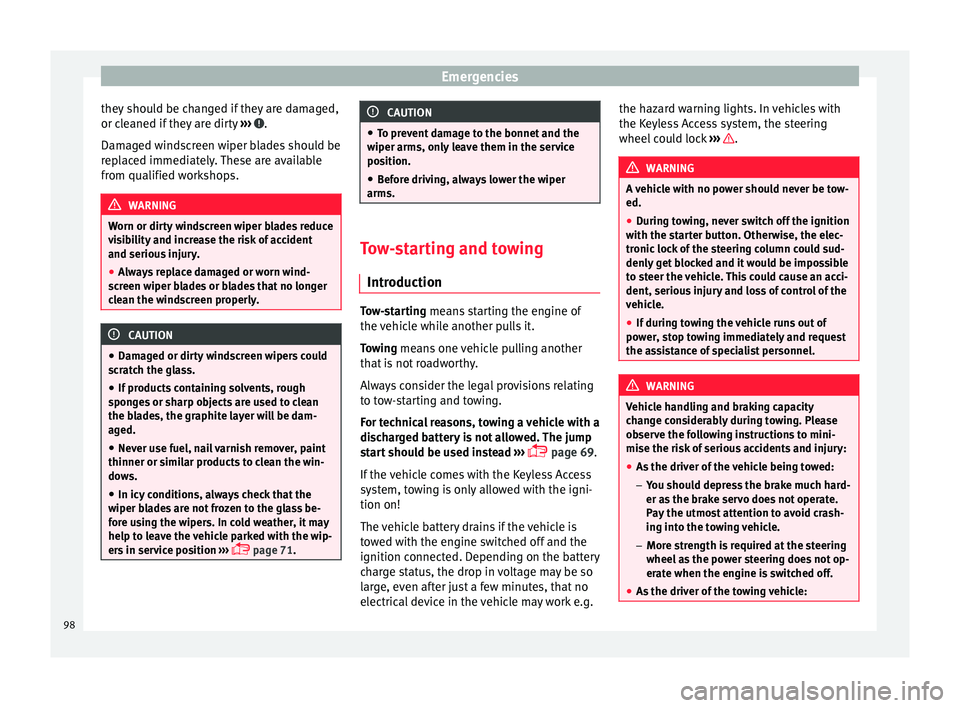
Emergencies
they should be changed if they are damaged,
or c l
e
aned if they are dirty âºâºâº .
Dam ag
ed w
indscreen wiper blades should be
replaced immediately. These are available
from qualified workshops. WARNING
Worn or dirty windscreen wiper blades reduce
vi s
ibility and increase the risk of accident
and serious injury.
â Always replace damaged or worn wind-
scr
een wiper blades or blades that no longer
clean the windscreen properly. CAUTION
â Damag ed or dir
ty windscreen wipers could
scratch the glass.
â If products containing solvents, rough
spong
es or sharp objects are used to clean
the blades, the graphite layer will be dam-
aged.
â Never use fuel, nail varnish remover, paint
thinner or simil
ar products to clean the win-
dows.
â In icy conditions, always check that the
wiper bl
ades are not frozen to the glass be-
fore using the wipers. In cold weather, it may
help to leave the vehicle parked with the wip-
ers in service position âºâºâº
ï¨ page 71. CAUTION
â To pr ev
ent damage to the bonnet and the
wiper arms, only leave them in the service
position.
â Before driving, always lower the wiper
arms. Tow-starting and towing
Introduction Tow-starting me
an
s
starting the engine of
the vehicle while another pulls it.
Towing means one vehicle pulling another
that is not roadworthy.
Always consider the legal provisions relating
to tow-starting and towing.
For technical reasons, towing a vehicle with a
discharged battery is not allowed. The jump
start should be used instead âºâºâº
ï¨ page 69.
If the vehicle comes with the Keyless Access
system, towing is only allowed with the igni-
tion on!
The vehicle battery drains if the vehicle is
towed with the engine switched off and the
ignition connected. Depending on the battery
charge status, the drop in voltage may be so
large, even after just a few minutes, that no
electrical device in the vehicle may work e.g. the hazard warning lights. In vehicles with
the Keyle
ss Access system, the steering
wheel could lock âºâºâº .
WARNING
A vehicle with no power should never be tow-
ed.
â During towing, never switch off the ignition
with the s t
arter button. Otherwise, the elec-
tronic lock of the steering column could sud-
denly get blocked and it would be impossible
to steer the vehicle. This could cause an acci-
dent, serious injury and loss of control of the
vehicle.
â If during towing the vehicle runs out of
power
, stop towing immediately and request
the assistance of specialist personnel. WARNING
Vehicle handling and braking capacity
ch an
ge considerably during towing. Please
observe the following instructions to mini-
mise the risk of serious accidents and injury:
â As the driver of the vehicle being towed:
â You shoul
d depress the brake much hard-
er as the brake servo does not operate.
Pay the utmost attention to avoid crash-
ing into the towing vehicle.
â More strength is required at the steering
wheel as the power steering does not op-
erate when the engine is switched off.
â As the driver of the towing vehicle: 98
Page 101 of 348
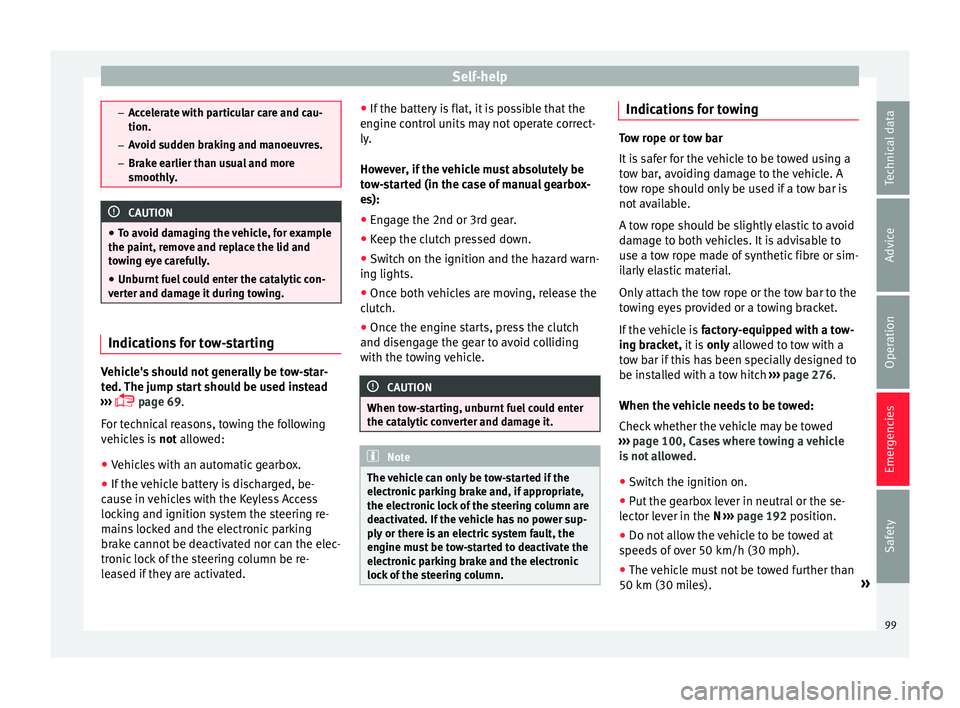
Self-help
â
Ac c
elerate with particular care and cau-
tion.
â Avoid sudden braking and manoeuvres.
â Brake earlier than usual and more
smoothly. CAUTION
â To av oid d
amaging the vehicle, for example
the paint, remove and replace the lid and
towing eye carefully.
â Unburnt fuel could enter the catalytic con-
vert
er and damage it during towing. Indications for tow-starting
Vehicle's should not generally be tow-star-
t
ed.
The jump s
tart should be used instead
âºâºâº ï¨ page 69.
For technical reasons, towing the following
vehicles is not allowed:
â Vehicles with an automatic gearbox.
â If the vehicle battery is discharged, be-
cause in
vehicles with the Keyless Access
locking and ignition system the steering re-
mains locked and the electronic parking
brake cannot be deactivated nor can the elec-
tronic lock of the steering column be re-
leased if they are activated. â
If the batt
ery is flat, it is possible that the
engine control units may not operate correct-
ly.
However, if the vehicle must absolutely be
tow-started (in the case of manual gearbox-
es):
â Engage the 2nd or 3rd gear.
â Keep the clutch pressed down.
â Switch on the ignition and the hazard warn-
ing lights.
â Once both
vehicles are moving, release the
clutc
h.
â Once the engine starts, press the clutch
and diseng
age the gear to avoid colliding
with the towing vehicle. CAUTION
When tow-starting, unburnt fuel could enter
the cat a
lytic converter and damage it. Note
The vehicle can only be tow-started if the
electr onic
parking brake and, if appropriate,
the electronic lock of the steering column are
deactivated. If the vehicle has no power sup-
ply or there is an electric system fault, the
engine must be tow-started to deactivate the
electronic parking brake and the electronic
lock of the steering column. Indications for towing
Tow rope or tow bar
It i
s
safer for the vehicle to be towed using a
tow bar, avoiding damage to the vehicle. A
tow rope should only be used if a tow bar is
not available.
A tow rope should be slightly elastic to avoid
damage to both vehicles. It is advisable to
use a tow rope made of synthetic fibre or sim-
ilarly elastic material.
Only attach the tow rope or the tow bar to the
towing eyes provided or a towing bracket.
If the vehicle is factory-equipped with a tow-
ing bracket, it is only allowed to tow with a
tow bar if this has been specially designed to
be installed with a tow hitch âºâºâº
page 276.
When the vehicle needs to be towed:
Check whether the vehicle may be towed
âºâºâº page 100, Cases where towing a vehicle
is not allowed .
â Switch the ignition on.
â Put the gearbox lever in neutral or the se-
lect or l
ever in the N âºâºâº
page 192 position.
â Do not allow the vehicle to be towed at
speeds
of over 50 km/h (30 mph).
â The vehicle must not be towed further than
50 km (30 mil e
s). »
99
Technical data
Advice
Operation
Emergencies
Safety
Page 104 of 348
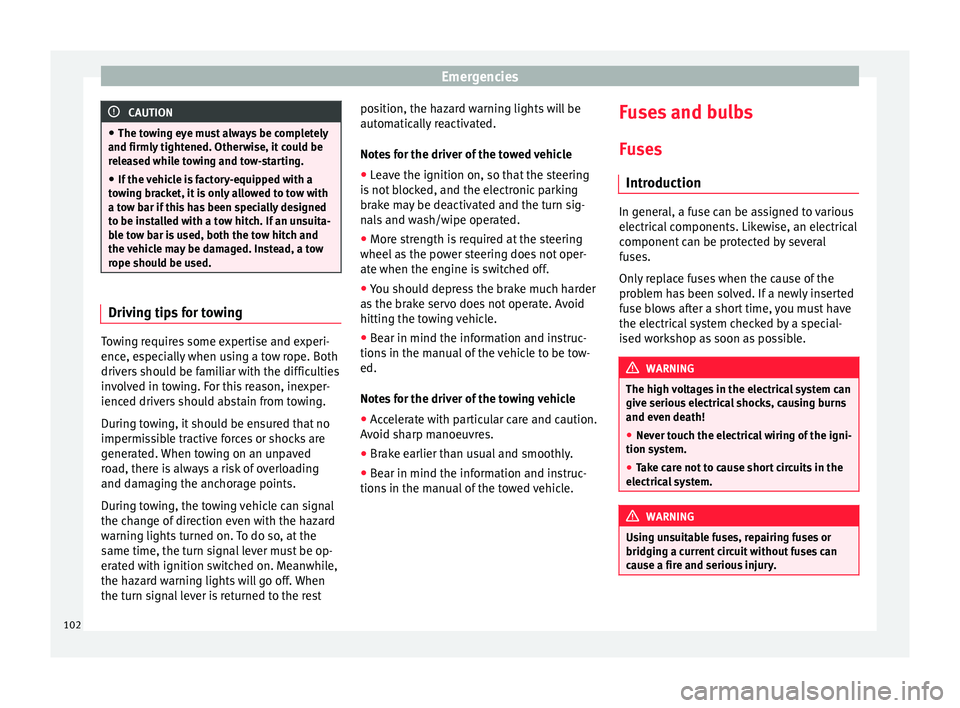
Emergencies
CAUTION
â The to w
ing eye must always be completely
and firmly tightened. Otherwise, it could be
released while towing and tow-starting.
â If the vehicle is factory-equipped with a
tow
ing bracket, it is only allowed to tow with
a tow bar if this has been specially designed
to be installed with a tow hitch. If an unsuita-
ble tow bar is used, both the tow hitch and
the vehicle may be damaged. Instead, a tow
rope should be used. Driving tips for towing
Towing requires some expertise and experi-
enc
e, e
s
pecially when using a tow rope. Both
drivers should be familiar with the difficulties
involved in towing. For this reason, inexper-
ienced drivers should abstain from towing.
During towing, it should be ensured that no
impermissible tractive forces or shocks are
generated. When towing on an unpaved
road, there is always a risk of overloading
and damaging the anchorage points.
During towing, the towing vehicle can signal
the change of direction even with the hazard
warning lights turned on. To do so, at the
same time, the turn signal lever must be op-
erated with ignition switched on. Meanwhile,
the hazard warning lights will go off. When
the turn signal lever is returned to the rest position, the hazard warning lights will be
automatic
ally reactivated.
Notes for the driver of the towed vehicle â Leave the ignition on, so that the steering
is not
blocked, and the electronic parking
brake may be deactivated and the turn sig-
nals and wash/wipe operated.
â More strength is required at the steering
wheel as
the power steering does not oper-
ate when the engine is switched off.
â You should depress the brake much harder
as the br
ake servo does not operate. Avoid
hitting the towing vehicle.
â Bear in mind the information and instruc-
tions in the m
anual of the vehicle to be tow-
ed.
Notes for the driver of the towing vehicle
â Accelerate with particular care and caution.
Avoid sh
arp manoeuvres.
â Brake earlier than usual and smoothly.
â Bear in mind the information and instruc-
tions in the m
anual of the towed vehicle. Fuses and bulbs
F u
se
s
Introduction In general, a fuse can be assigned to various
electric
al
components. Likewise, an electrical
component can be protected by several
fuses.
Only replace fuses when the cause of the
problem has been solved. If a newly inserted
fuse blows after a short time, you must have
the electrical system checked by a special-
ised workshop as soon as possible. WARNING
The high voltages in the electrical system can
give seriou s
electrical shocks, causing burns
and even death!
â Never touch the electrical wiring of the igni-
tion syst
em.
â Take care not to cause short circuits in the
electrica
l system. WARNING
Using unsuitable fuses, repairing fuses or
bridging a c urr
ent circuit without fuses can
cause a fire and serious injury. 102
Page 105 of 348
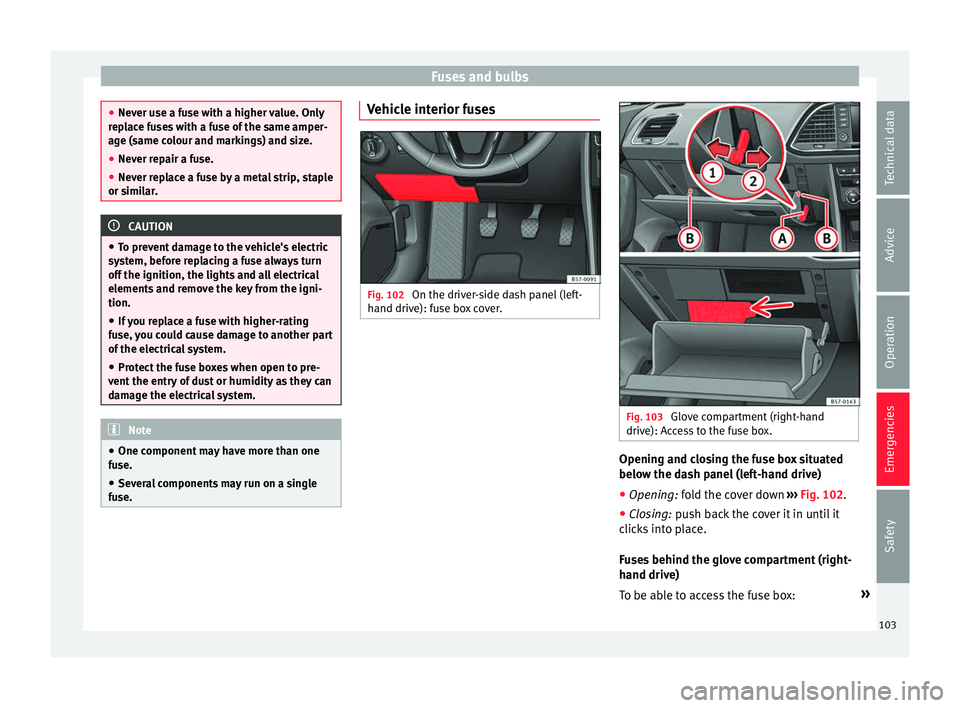
Fuses and bulbs
â
Never u se a f
use with a higher value. Only
replace fuses with a fuse of the same amper-
age (same colour and markings) and size.
â Never repair a fuse.
â Never replace a fuse by a metal strip, staple
or simil
ar. CAUTION
â To pr ev
ent damage to the vehicle's electric
system, before replacing a fuse always turn
off the ignition, the lights and all electrical
elements and remove the key from the igni-
tion.
â If you replace a fuse with higher-rating
fuse,
you could cause damage to another part
of the electrical system.
â Protect the fuse boxes when open to pre-
vent the entr
y of dust or humidity as they can
damage the electrical system. Note
â One component m
ay have more than one
fuse.
â Several components may run on a single
fuse. Vehicle interior fuses
Fig. 102
On the driver-side dash panel (left-
h and driv
e): f
use box cover. Fig. 103
Glove compartment (right-hand
driv e): A
c
cess to the fuse box. Opening and closing the fuse box situated
belo
w the d
a
sh panel (left-hand drive)
â Opening: fold the cover down âºâº
⺠Fig. 102.
â Closing: push back the cover it in until it
clic
ks into place.
Fuses behind the glove compartment (right-
hand drive)
To be able to access the fuse box: »
103
Technical data
Advice
Operation
Emergencies
Safety
Page 108 of 348

Emergencies
â
Ple a
se note that the above lists, while cor-
rect at the time of printing, are subject to
change. Changing a bulb
Topic intr
oductionRead the additional information carefully
âºâº âº
ï¨ page 62.
Changing bulbs requires a certain degree of
practical skill.
If you choose to change the engine compart-
ment lamps yourself, remember that it is a
dangerous area âºâºâº in Working in the en-
gine c omp
ar
tment on page 299.
Always use identical bulbs with the same
designation. The name can be found on the
base of the bulb holder.
Depending on how equipped the vehicle is,
there are different sets of headlights and tail
lights:
â Halogen headlights.
â Full-LED main headlights*
â Rear bulb light
â LED rear light* Full-LED headlight system*
Ful
l-LED headlights handle all light functions
(daylight, side light, turn signal, dipped
beam and route light) with light emitting di-
odes (LEDs) as a light source.
Full-LED headlights are designed to last the
lifetime of the car and light bulbs cannot be
replaced. In case of headlight failure, go to
an authorised workshop to have it replaced. WARNING
â Tak e p
articular care when working on com-
ponents in the engine compartment if the en-
gine is warm. Risk of burns.
â Bulbs are highly sensitive to pressure. The
glas
s can break when you touch the bulb,
causing injury.
â When changing bulbs, please take care not
to injure
yourself on sharp edges, in particu-
lar on the headlight housing. CAUTION
â Remo v
e the ignition key before working on
the electric system. Otherwise, a short circuit
could occur.
â Switch off the lights and the parking light
before c
hanging a bulb.
â Take good care to avoid damaging any com-
ponents. For the sake of the environment
Please ask your specialist retailer how to dis-
pose of u
sed bulbs in the proper manner. Note
â Ple a
se check at regular intervals that all
lighting (especially the exterior lighting) on
your vehicle is functioning properly. This is
not only in the interest of your own safety,
but also that of all other road users.
â Before changing a bulb, make sure you
have the c
orrect new bulb.
â Do not touch the glass part of the bulb with
your bar
e hands, use a cloth or paper towel
instead, since the fingerprints left on the
glass will vaporise as a result of the heat gen-
erated by the bulb, they will be deposited on
the reflector and will impair its surface.
â Depending on the level of equipment fitted
in the vehic
le, LEDs may be used for part or
all of the interior and/or exterior lighting.
LEDs have an estimated life that exceeds than
that of the car. If an LED light fails, go to an
authorised workshop for its replacement. 106
Page 115 of 348
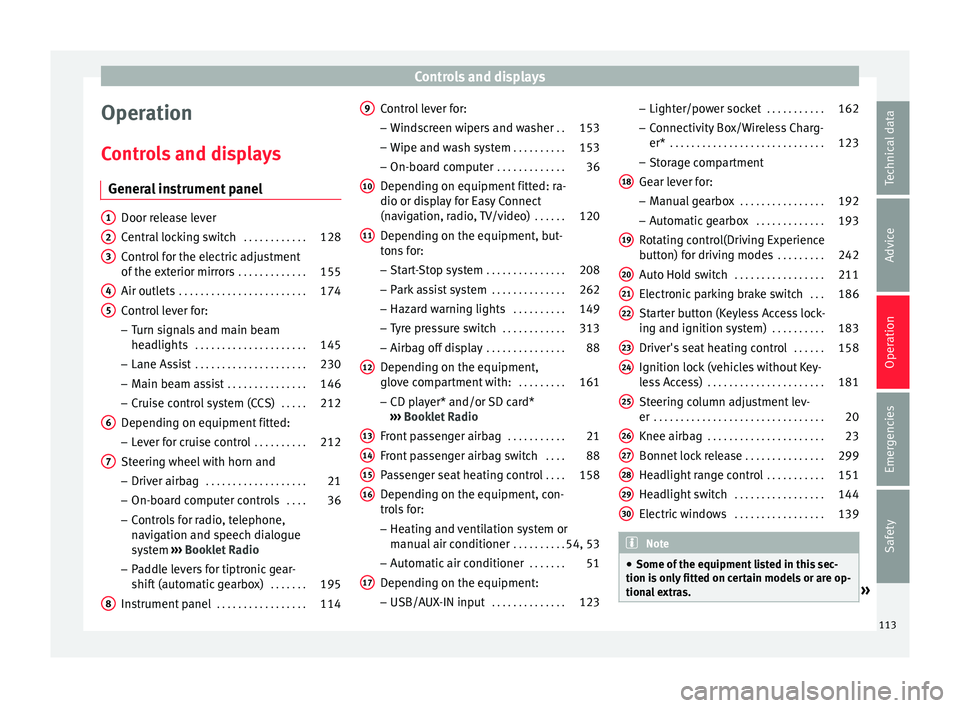
Controls and displays
Operation
C ontr
o
ls and displays
General instrument panel Door release lever
Centr
al
locking switch . . . . . . . . . . . .128
Control for the electric adjustment
of the ext
erior mirrors . . . . . . . . . . . . . 155
Air outlets . . . . . . . . . . . . . . . . . . . . . . . . 174
Control lever for:
â Turn s ign
als and main beam
headlights . . . . . . . . . . . . . . . . . . . . . 145
â Lane Ass i
st . . . . . . . . . . . . . . . . . . . . . 230
â Main beam a
ssist . . . . . . . . . . . . . . . 146
â Cruise c
ontrol system (CCS) . . . . .212
Depending on equipment fitted:
â Lev er f
or cruise control . . . . . . . . . .212
Steering wheel with horn and â Driver airbag . . . . . . . . . . . . . . . . . . . 21
â On-boar d c
omputer controls . . . .36
â Contro
ls for radio, telephone,
navigation and speech dialogue
system âºâºâº
Booklet Radio
â Paddle levers for tiptronic gear-
shift (automatic gearbox) . . . . . . .195
Instrument panel . . . . . . . . . . . . . . . . . 114
1 2
3
4
5
6
7
8 Control lever for:
â Wind
s
creen wipers and washer . .153
â Wipe and wa
sh system . . . . . . . . . . 153
â On-board c
omputer . . . . . . . . . . . . . 36
Depending on equipment fitted: ra-
dio or disp
lay for Easy Connect
(navigation, radio, TV/video) . . . . . .120
Depending on the equipment, but-
tons
for:
â Start-Stop system . . . . . . . . . . . . . . . 208
â Park a
ssist system . . . . . . . . . . . . . . 262
â Hazard w
arning lights . . . . . . . . . .149
â Tyr
e pressure switch . . . . . . . . . . . .313
â Airbag off di
splay . . . . . . . . . . . . . . . 88
Depending on the equipment,
glov e c
ompartment with: . . . . . . . . .161
â CD pl a
yer* and/or SD card*
âºâºâº Booklet Radio
Front passenger airbag . . . . . . . . . . .21
Front passenger airbag switch . . . .88
Passenger seat heating control . . . .158
Depending on the equipment, con-
tro l
s for:
â Heating and ventilation system or
manual air conditioner . . . . . . . . . .54, 53
â Autom atic
air conditioner . . . . . . .51
Depending on the equipment:
â USB/A UX-IN inp
ut . . . . . . . . . . . . . . 123
9
10
11
12
13
14
15
16
17 â
Light er/po
w
er socket . . . . . . . . . . . 162
â Connectivity
Box/Wireless Charg-
er* . . . . . . . . . . . . . . . . . . . . . . . . . . . . . 123
â Storag
e compartment
Gear lever for: â Manual gearbox . . . . . . . . . . . . . . . . 192
â Automatic
gearbox . . . . . . . . . . . . . 193
Rotating control(Driving Experience
button) f
or driving modes . . . . . . . . .242
Auto Hold switch . . . . . . . . . . . . . . . . . 211
Electronic parking brake switch . . .186
Starter button (Keyless Access lock-
ing and ignition sys
tem) . . . . . . . . . . 183
Driver's seat heating control . . . . . .158
Ignition lock (vehicles without Key-
les
s Access) . . . . . . . . . . . . . . . . . . . . . . 181
Steering column adjustment lev-
er . . . . . . . . . . . . . . . . . . . . . . . . . . . . . . . . 20
Knee airbag . . . . . . . . . . . . . . . . . . . . . . 23
Bonnet lock release . . . . . . . . . . . . . . .299
Headlight range control . . . . . . . . . . .151
Headlight switch . . . . . . . . . . . . . . . . . 144
Electric windows . . . . . . . . . . . . . . . . . 139 Note
â Some of the equipment li
sted in this sec-
tion is only fitted on certain models or are op-
tional extras. » 18
19
20
21
22
23
24
25
26
27
28
29
30
113
Technical data
Advice
Operation
Emergencies
Safety
Page 118 of 348
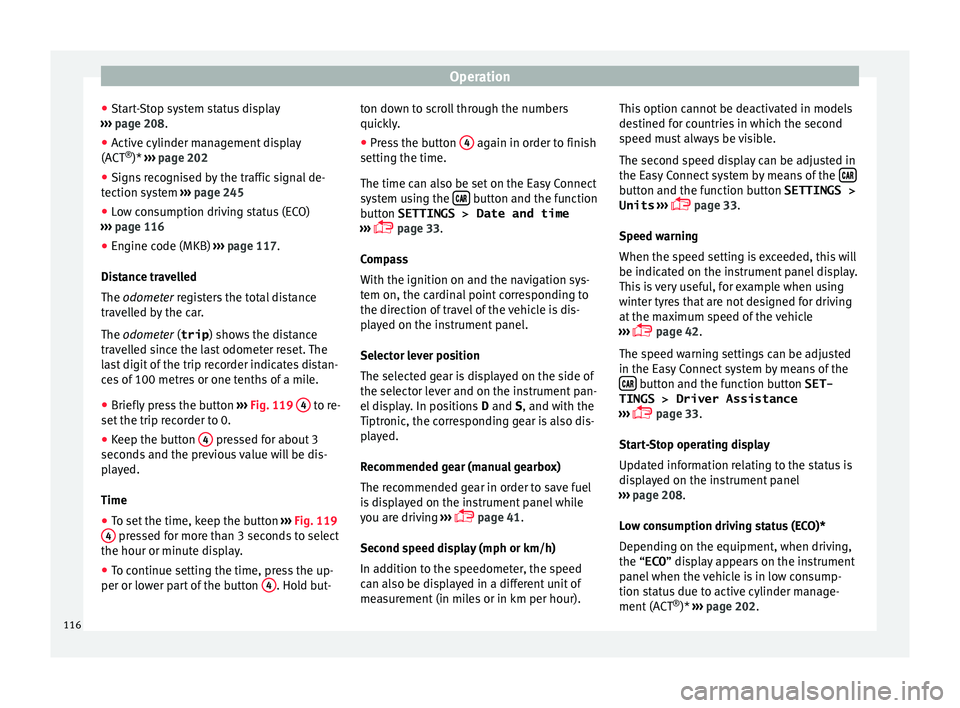
Operation
â St ar
t
-Stop system status display
âºâºâº page 208.
â Active cylinder management display
(ACT ®
)* âºâº
⺠page 202
â Signs recognised by the traffic signal de-
tection sys
tem âºâºâº page 245
â Low consumption driving status (ECO)
âºâºâº
page 116
â Engine code (MKB) âºâºâº
page 117.
Distance travelled
The odometer registers the total distance
travelled by the car.
The odometer (trip ) shows the distance
travelled since the last odometer reset. The
last digit of the trip recorder indicates distan-
ces of 100 metres or one tenths of a mile.
â Briefly press the button âºâºâº
Fig. 119 4 to re-
set the trip r
ec
order to 0.
â Keep the button 4 pressed for about 3
sec ond
s
and the previous value will be dis-
played.
Time
â To set the time, keep the button âºâºâº
Fig. 119
4 pressed for more than 3 seconds to select
the hour or minut e di
s
play.
â To continue setting the time, press the up-
per or lower p
art of the button 4 . Hold but-ton down to scroll through the numbers
quic
k
ly
.
â Press the button 4 again in order to finish
settin g the time.
The time c an al
so be set on the Easy Connect
system using the ïïï button and the function
b utt
on
SETTINGS > Date and time
âºâºâº ï¨ page 33.
Compass
With the ignition on and the navigation sys-
tem on, the cardinal point corresponding to
the direction of travel of the vehicle is dis-
played on the instrument panel.
Selector lever position
The selected gear is displayed on the side of
the selector lever and on the instrument pan-
el display. In positions D and S, and with the
Tiptronic, the corresponding gear is also dis-
played.
Recommended gear (manual gearbox)
The recommended gear in order to save fuel
is displayed on the instrument panel while
you are driving âºâºâº
ï¨ page 41.
Second speed display (mph or km/h)
In addition to the speedometer, the speed
can also be displayed in a different unit of
measurement (in miles or in km per hour). This option cannot be deactivated in models
destined f
or countries in which the second
speed must always be visible.
The second speed display can be adjusted in
the Easy Connect system by means of the ïïï button and the function button SETTINGS >
Units ⺠âº
âº
ï¨ page 33.
Speed warning
When the speed setting is exceeded, this will
be indicated on the instrument panel display.
This is very useful, for example when using
winter tyres that are not designed for driving
at the maximum speed of the vehicle
âºâºâº ï¨ page 42.
The speed warning settings can be adjusted
in the Easy Connect system by means of the ïïï button and the function button SET-
TINGS > Driver Assistance
⺠âº
âº
ï¨ page 33.
Start-Stop operating display
Updated information relating to the status is
displayed on the instrument panel
âºâºâº page 208.
Low consumption driving status (ECO)*
Depending on the equipment, when driving,
the âECO â display appears on the instrument
panel when the vehicle is in low consump-
tion status due to active cylinder manage-
ment (ACT ®
)* âºâºâº page 202.
116